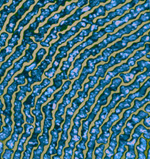Investigations
Citations
 A
big "nano-nano" to tiny wires
A
big "nano-nano" to tiny wires
What happens when you coat a layer of two basic plastics with
silver? Nanoscopic wires assemble themselves in numerous, parallel,
and continuous lines. In the December 13 Nature, physics
professor Heinrich Jaeger and Ward Lopes, SM'99, PhD'01, describe
their discovery and a technique for precisely controlling the
wires' growth. The nanowires measure 30 nanometers by 10 nanometers
in diameter. (At a billionth of a meter, a nanometer is the width
of a double strand of DNA.) The technique could eventually be
used to produce high-density computer disks and to make lenses
for X-ray lithography, a process for transferring ultrasmall patterns
to silicon computer chips.
Journey
to the center of the Earth
The
chemical makeup of the Earth's center is surprisingly complicated,
report doctoral student Jung-Fu Lin and geophysical-sciences associate
professor Dion Heinz in the January 11 Science. When the researchers
simulated searing subsurface temperatures of 4,200 degrees Fahrenheit
and crushing pressures of 840,000 atmospheres (or 12.3 million
pounds per square inch), they found that the core consists of
two exotic forms of iron-instead of one, as previously believed.
The iron forms may be alloyed with silicon, contradicting previous
studies that ruled out silicon in favor of another light element
such as oxygen, sulfur, hydrogen, or carbon. Lin says the finding
makes sense, given silicon's abundance in the solar system, its
tendency to alloy with iron, and its ability to lower the density
of iron under high pressure.
Sobering
statistics
Drunk drivers are at least 13 times more likely to cause a fatal
crash than are sober drivers, note economics professor Steven
Levitt and Harvard economist Jack Porter in the December Journal
of Political Economy. Are some don't-drink-and-drive deterrents
more effective than others? Yes, says Levitt: states with stiff
mandatory punishments for repeat drunk-driving offenders or a
high number of police patrols devoted to catching drunk drivers
have great success in lowering alcohol-related fatalities.
Jane
Addams as public intellectual
The
founder of Chicago's famed Hull-House and the first American woman
to win the Nobel Peace Prize has for too long been misunderstood
as a mere "do-gooder," argues Jean Bethke Elshtain in
Jane Addams and the Dream of American Democracy (Basic Books,
2001). In fact, Addams was a quintessential "public intellectual,"
says Elshtain, the Laura Spelman Rockefeller professor in divinity,
political science, and international relations. In Addams's hands,
she says, Hull-House was a cultural and intellectual center, a
place where "beauty was served."
Spray
and sniff
Nasal sprays are more effective than antihistamines
when used as needed for seasonal allergies such as hay fever,
according to a study by Robert Naclerio, chief of otolaryngology,
in the November 26 Archives of Internal Medicine. The finding
challenges common prescribing practices, which favor antihistamines
over corticosteroid sprays as the first-line treatment for the
one in five Americans with seasonal allergies.
A
parable of penal reform
Norval Morris, the Julius Kreeger professor emeritus of law, is
given to parables. His latest is Maconochie's Gentlemen: The
Story of Norfolk Island and the Roots of Modern Prison Reform
(Oxford, 2001), a fictionalized account of Alexander Maconochie,
a retired naval captain who in 1840 became superintendent of 2,000
twice-convicted prisoners on an island off the Australian coast.
In four years Maconochie transformed the brutal convict settlement
into a controlled, stable, productive environment whose prisoners
came to be called "Maconochie's Gentlemen." Morris's
lesson, related in the epilogue: that present-day "supermax"
prisons with their harsh conditions are not the only way to control
society's "worst of the worst."
-S.A.S.

![]()
 A
big "nano-nano" to tiny wires
A
big "nano-nano" to tiny wires